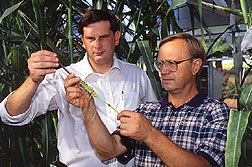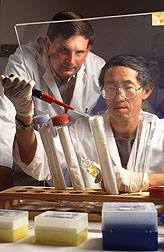Revolutionizing Hybrid Corn Production
|
|
For more than 50 years, one of the most cherished dreams of plant breeders has been to find a way to transform corn and other cereal grains into super-plants able to reproduce by themselves without losing hybrid vigor, desirable agronomic traits, or useful disease- or insect-resistance.
The term for this type of vegetative miracle is "apomixis."
This year, Agricultural Research Service scientists took a giant leap toward realizing their dream. They obtained the first patent on an apomictic plant--Patent No. 5,710,367, "Apomictic Maize"--from the U.S. Patent and Trademark Office. Their next goal: to pinpoint and patent the specific gene or genes responsible for this trait in corn.
Apomixis is an asexual type of reproduction in which the plant embryos grow from egg cells without being fertilized by pollen--the male part of the plant.
"Apomixis is a natural way of cloning plants through seed. It offers plant breeders a unique system for developing new and distinctive cultivars in many species," says plant geneticist Bryan K. Kindiger, who is at the ARS Southern Plains Range Research Station in Woodward, Oklahoma. "Apomixis will give scientists a potent tool to create hybrids that can produce generations of genetically identical plants that retain their original hybrid genetics."
Various forms of apomixis have been reported for over 300 species representing more than 35 families of plants. Apomixis is known to occur in many subtropical and tropical forage grasses, in citrus, and in wild relatives of many crops like sorghum, beets, strawberries, and mangos.
After more than 5 years of research using both classical and molecular breeding methods, Kindiger and a team of research associates successfully developed apomictic corn plants that look, grow, and taste like corn. Kindiger's team included ARS molecular biologist Ann Blakey, ARS geneticists Dapeng Bai and Yong Li, visiting Russian cytogeneticist Victor Sokolov, Moldavian corn breeder Sergiu Cealic, and technician Luida Cealic, also from Moldavia.
"We call the plants our apomictic corn prototypes," says Kindiger. "This is the first time a sexual species has been successfully transformed into an apomictic form.
"Apomictic corn that can maintain its hybrid vigor and desirable agronomic traits from one generation to the next has been a dream of plant breeders for decades," Kindiger notes.
"Today's hybrid corn retains its hybrid vigor and desirable genetic traits for only a single generation," he continues. "This means farmers have to buy and plant new hybrid seed each year.
"With an apomictic hybrid, these desirable traits could be maintained indefinitely, with no loss of hybrid vigor. In addition, hybrids of many species of plants that are now considered difficult or too expensive to produce by normal breeding techniques could be generated for the first time," Kindiger says.
For the apomictic corn project, the genes that confer apomixis were obtained from eastern gamagrass, Tripsacum dactyloides. It is a wild, native grass species with a gene pool that has a lot to offer corn--traits like resistance to cold and to insects, as well as drought and flood tolerance, says Kindiger.
Russian Roots
Kindiger credits Russian scientist Dimitri Petrov and his colleagues at the Institute of Cytology and Genetics at Novosibirsk in Siberia, Russia, for their pioneering research in beginning the transfer of apomixis to corn using its distant relative, gamagrass.
"In the 1960s, the Petrov laboratory was the first to successfully define the model for transferring apomixis to corn," Kindiger says. "Using the technology of the period, they came close to identifying the particular chromosome carrying the apomixis genes. "We have been able to confirm much of their early results and continue to move the project forward, thanks to newer genetic technologies," he says.
In 1993, Kindiger and other ARS scientists began a 4-year cooperative research project with the Russian institute to reevaluate Petrov's plant germplasm and attempt to generate an apomictic corn prototype.
Since 1993, the team has been working with Sokolov, who heads the apomixis laboratory at the institute. The team has introduced numerous seed stocks from Russia.
"Petrov's initial apomictic hybrid possessed 20 corn and 36 Tripsacum chromosomes. By backcrossing his hybrid with a corn line, we identified materials that possessed 38 chromosomes (20 corn and 18 Tripsacum) and 39 chromosomes (30 corn and 9 Tripsacum). All retained the apomixis genes," says Kindiger.
"This is a major achievement, since it is extremely rare to reduce the genomic contribution to even 18--but especially to 9--Tripsacum chromosomes and still retain apomixis," says Phillip L. Sims, who heads the Woodward research station.
By evaluating apomictic lines backcrossed with corn, the team identified a single apomictic family that possessed a unique chromosome. Its Tripsacum chromosome segment, carrying the apomixis genes, was transferred to an intact chromosome of corn.
Development of this corn line led to the team's applying for a USDA patent on apomictic corn, which they received in January 1997. Kindiger and Sokolov are named as co-inventors on the patent.
"It's the first time the Tripsacum genes controlling apomixis have been attached to a corn chromosome," says Sims.
In an attempt to isolate the genes controlling apomixis, Kindiger and colleagues have developed a genomic library of corn and Tripsacum. The apomixis library consists of about 215,000 segments of DNA from both corn and Tripsacum.
"This library provides us with more than 94 percent of both the corn and Tripsacum genomes. And it affords us an excellent vehicle to isolate the specific segment of DNA containing the apomixis gene or genes," Kindiger says.
"By systematically screening the library with molecular markers, or tags, that have been shown to have a strong link to the apomixis genes, we expect to find and isolate the genes controlling the trait," he says.
"Once the apomictic genes have been isolated and confirmed, they could be transferred to any line of corn or other cereal crops, such as wheat, sorghum, or rice by genetic transformation techniques," says Sims. "Then, plant breeders can use apomixis to lock in traits like high yields, disease- and insect-resistance, and other important improvements in cereal and forage crops."
The apomictic maize patent has attracted the interest of many seed companies because it can lower the cost of hybrid seed improvement, says Sims.
Currently, hybrid corn is produced in blocks by crossing two inbred corn lines. "Each year, millions of dollars and hundreds of thousands of acres of valuable farmland are invested in this task," says Kindiger.
Sims is working with top U.S. corn seed companies on details regarding trust fund agreements. Under the terms of the agreement, in return for helping the ARS scientists clone the gene or genes responsible for apomixis in corn, the companies would be able to license those genes from USDA for use in hybrid corn lines.
Says Sims, "Developing apomictic corn and cereal crops could profoundly change the future of agriculture."--By Hank Becker, Agricultural Research Service Information Staff.
Bryan K. Kindiger and Phillip L. Sims are at the USDA-ARS Southern Plains Research Station, 2000 18th St., Woodward, OK 73801; phone (580) 256-7449, fax (580) 256-1322.
"Revolutionizing Hybrid Corn Production" was published in the December 1998 issue of Agricultural Research magazine.








